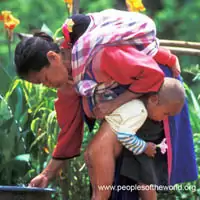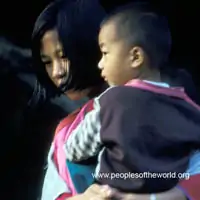The Indigenous Lisu People
Ethnonyms: Lisaw Countries inhabited: Thailand, China, Burma (Myanmar), India Language family: Tibeto-Burman Language branch: Lolo

 The indigenous Lisu people have a very interesting folkloric history about the origin of their people.
One day there came a great flood, which drowned all but a boy and his sister.
Knowing of the incest taboo, they looked for omens to help them decide whether to
let the human race die out or to continue it. Eventually, they married and had children
who, in turn, married each other to begin all the other peoples of the world. In an
even stranger twist, the story tells of how, lacking a female partner, the man who would eventually
begin the Akha people had to marry a monkey.
The indigenous Lisu people have a very interesting folkloric history about the origin of their people.
One day there came a great flood, which drowned all but a boy and his sister.
Knowing of the incest taboo, they looked for omens to help them decide whether to
let the human race die out or to continue it. Eventually, they married and had children
who, in turn, married each other to begin all the other peoples of the world. In an
even stranger twist, the story tells of how, lacking a female partner, the man who would eventually
begin the Akha people had to marry a monkey.

 The Lisu are a proud people. Their traditional dress is among the most colorful of any people anywhere.
Depending on how much contact a village has had with its
more western-influenced neighbors, the visitor will find more or less evidence of this
color. In the village shown in these first few pictures, clothes are still mostly hand-made. Although you will see only women
and girls making traditional Lisu clothes (Lisu men are busy making crossbows for
hunting, musical instruments and animal traps), Lisu men and boys can be found wearing
them daily more than any other ethnic group I have visited in this part of the world.
In fact, some have subdivided the Lisu into White, Black and Flower Lisu based only
on the distinctive dress that has become the custom in the different areas where they
live.
The Lisu are a proud people. Their traditional dress is among the most colorful of any people anywhere.
Depending on how much contact a village has had with its
more western-influenced neighbors, the visitor will find more or less evidence of this
color. In the village shown in these first few pictures, clothes are still mostly hand-made. Although you will see only women
and girls making traditional Lisu clothes (Lisu men are busy making crossbows for
hunting, musical instruments and animal traps), Lisu men and boys can be found wearing
them daily more than any other ethnic group I have visited in this part of the world.
In fact, some have subdivided the Lisu into White, Black and Flower Lisu based only
on the distinctive dress that has become the custom in the different areas where they
live.
They save their best clothes, though, for the lunar New Year celebration. Here each Lisu girl and boy tries to out-do the next for the finest costume. Not only is the mix of bright colors important; belts, tassels, headdress and silver jewelry all play their part in determining the best-dressed for the occasion. Even men and boys wear special New Year clothing and adorn themselves in fine silver jewelry. As with many other tribal groups in this area, New Year is especially a time for courtship. Among the garb made specially for the occasion are "courting bags." Again each tries to out-do the other in an attempt to woo the best boyfriend or girlfriend.
Lisu villages tend to be large, often with around 2,000 inhabitants. They are typically built close to a source of water such as a stream. This is not only for practical reasons: The Lisu believe in a divine power possessed by water. Each village also sets aside an area for altars venerating different spirits. The most important of these is the village guardian spirit. Offerings are left in these altars and occasional, special ceremonies are conducted here.

 I first stayed in a Lisu village that was used to having electricity. This
is becoming more common in Thailand but is still the exception there and in
other countries where the Lisu live. I chanced to arrive on "haircut" day. Although I didn't
need a haircut, I decided to break the ice by letting the village barber
make my hair even shorter than it already was.
The ice was broken and my new friends dubbed me "Aloahp'ha" — which, in their language, means the
sixth-born son. Four men in particular, including the barber, undertook a personal
mission to ensure my time with them was a pleasant one.
They explained to me that in northern Thailand, beauty pageants are sometimes held in which young girls from the various
tribal groups in the area compete —
a kind of "Miss Hilltribe Thailand" I imagined it to be. It was with deep pride that they assured me
the winner is always a Lisu girl.
I first stayed in a Lisu village that was used to having electricity. This
is becoming more common in Thailand but is still the exception there and in
other countries where the Lisu live. I chanced to arrive on "haircut" day. Although I didn't
need a haircut, I decided to break the ice by letting the village barber
make my hair even shorter than it already was.
The ice was broken and my new friends dubbed me "Aloahp'ha" — which, in their language, means the
sixth-born son. Four men in particular, including the barber, undertook a personal
mission to ensure my time with them was a pleasant one.
They explained to me that in northern Thailand, beauty pageants are sometimes held in which young girls from the various
tribal groups in the area compete —
a kind of "Miss Hilltribe Thailand" I imagined it to be. It was with deep pride that they assured me
the winner is always a Lisu girl.
 Despite the modern appearance of some villages with their electricity, televisions and
concrete slab houses, Lisu village life is surprisingly traditional.
Despite the modern appearance of some villages with their electricity, televisions and
concrete slab houses, Lisu village life is surprisingly traditional.
 Not only do the Lisu maintain their traditional dress on a daily basis, their Animist and ancestor-worshipping
religious beliefs and ceremonies are almost as widely practiced today as they have ever been.
Traditional crops remain much the same also, although opium poppy is much less commonly cultivated these days.
Not only do the Lisu maintain their traditional dress on a daily basis, their Animist and ancestor-worshipping
religious beliefs and ceremonies are almost as widely practiced today as they have ever been.
Traditional crops remain much the same also, although opium poppy is much less commonly cultivated these days.
Daily conduct is very much determined by an elaborate belief system based in the spirit world. The Lisu believe in a single creator, Wu Sa. Beside the creator there are many forms of spirit at work in daily life — from spirits of deceased ancestors to spirits of forests and other inanimate objects. The Lisu also probably pre-date the Roma in their belief in vampires. Since they are not surrounded by wolves, it is not surprising that werewolves do not figure in their list of evil spirits — "weretigers" take their place.

 Lisu daily life is also influenced to a large extent by clan membership. Inter-clan
competition can be fierce — even violent at times. Lisu clans are patrilineal —
the name following the male line. The six main clans have interesting names. These are
roughly translated into English as: Bear, Buckwheat, Fish, Hemp, Honey and Wood.
The eldest living male member of any clan is highly respected by his clansmen and clanswomen.
He wields a high degree of political power and is the most influential in important decisions.
Lisu daily life is also influenced to a large extent by clan membership. Inter-clan
competition can be fierce — even violent at times. Lisu clans are patrilineal —
the name following the male line. The six main clans have interesting names. These are
roughly translated into English as: Bear, Buckwheat, Fish, Hemp, Honey and Wood.
The eldest living male member of any clan is highly respected by his clansmen and clanswomen.
He wields a high degree of political power and is the most influential in important decisions.
In matters of inter-clan conflict or decisions affecting an entire village, though, it is the village headman who has supreme authority. His role is a political one. He arbitrates in matters of dispute and assesses and levies fines and other forms of punishment to offending villagers. Non-political village affairs can be broadly defined as religious and spiritual. A priest takes charge of religious affairs for each village. An elected role, this man mediates with the village guardian spirit and announces days of traditional Lisu importance, such as the New Year. Spiritual matters are in the hands of one or more village shamans.

 Shamanism is thought to be a path to which special men are called. The shaman is
the one who can communicate with the spirit world to determine, for example, causes of illness.
Although most Lisu today include western medical practice among the
options they consider for curing the sick, this is often a last resort and is
undertaken only after a shaman has deemed it appropriate. Indeed, until very recently
many Lisu would not consider sending a sick person to a hospital in the belief that a
place with so many sick people must be possessed by many evil spirits. So shamans call
on a repertoire of other cures including animal sacrifice, tying string around the
neck, arms, wrists and legs of their patient and soul-calling ceremonies if it is
determined that the soul has left the body. A shaman is also able to perform a kind of
exorcism ceremony. During such an exorcism he will use hot cooking fat and flames to
spit fire from his mouth — in a way we might see done at a circus. The shaman is
also called on to perform a ceremonial vanquishing of a deceased person's soul
after the corpse has been buried.
Shamanism is thought to be a path to which special men are called. The shaman is
the one who can communicate with the spirit world to determine, for example, causes of illness.
Although most Lisu today include western medical practice among the
options they consider for curing the sick, this is often a last resort and is
undertaken only after a shaman has deemed it appropriate. Indeed, until very recently
many Lisu would not consider sending a sick person to a hospital in the belief that a
place with so many sick people must be possessed by many evil spirits. So shamans call
on a repertoire of other cures including animal sacrifice, tying string around the
neck, arms, wrists and legs of their patient and soul-calling ceremonies if it is
determined that the soul has left the body. A shaman is also able to perform a kind of
exorcism ceremony. During such an exorcism he will use hot cooking fat and flames to
spit fire from his mouth — in a way we might see done at a circus. The shaman is
also called on to perform a ceremonial vanquishing of a deceased person's soul
after the corpse has been buried.
With their elaborate dress, ceremonies, belief systems and customs the Lisu are among the most fascinating of ethnic minority peoples one can visit in Southeast Asia. Along with the Hmong, they have retained their culture and autonomy from outside influences remarkably well as they have been exposed to forces like missionary conversion and globalization. Yet, like other groups, many Lisu — especially the current generation — have fallen victim to the destructive influences of assimilation to their surrounding world. Drug addiction, crime and prostitution are not unknown to the Lisu. Organizations like the Life Development Center (see Web Links below), as well as others listed elsewhere on our site, are today helping the Lisu face some of the "most evil spirits" they have ever encountered.
Photography copyright © 1999 - 2025, Ray Waddington. All rights reserved. Text copyright © 1999 - 2025, The Peoples of the World Foundation. All rights reserved.

Waddington, R. (2003), The Indigenous Lisu People. The Peoples of the World Foundation. Retrieved December 18, 2025, from The Peoples of the World Foundation. <https://www.peoplesoftheworld.org/text?people=Lisu>
Web Links Lisu Hill Tribe Experience Life Development Center Books Maitra, A., (1993) Profile of a little-known tribe: An ethnographic study of Lisus of Arunachal Pradesh. New Delhi: Mittal Publications. Hutheesing, O. K., (1990) Emerging Sexual Inequality among the Lisu of Northern Thailand: The Waning of Dog & Elephant Repute. Boston, MA: Brill Academic Publishers. Durrenberger, E. P., (1989) Lisu Religion. Northern Illinois University: Center for Southeast Asian Studies, Occasional Paper No.13.


